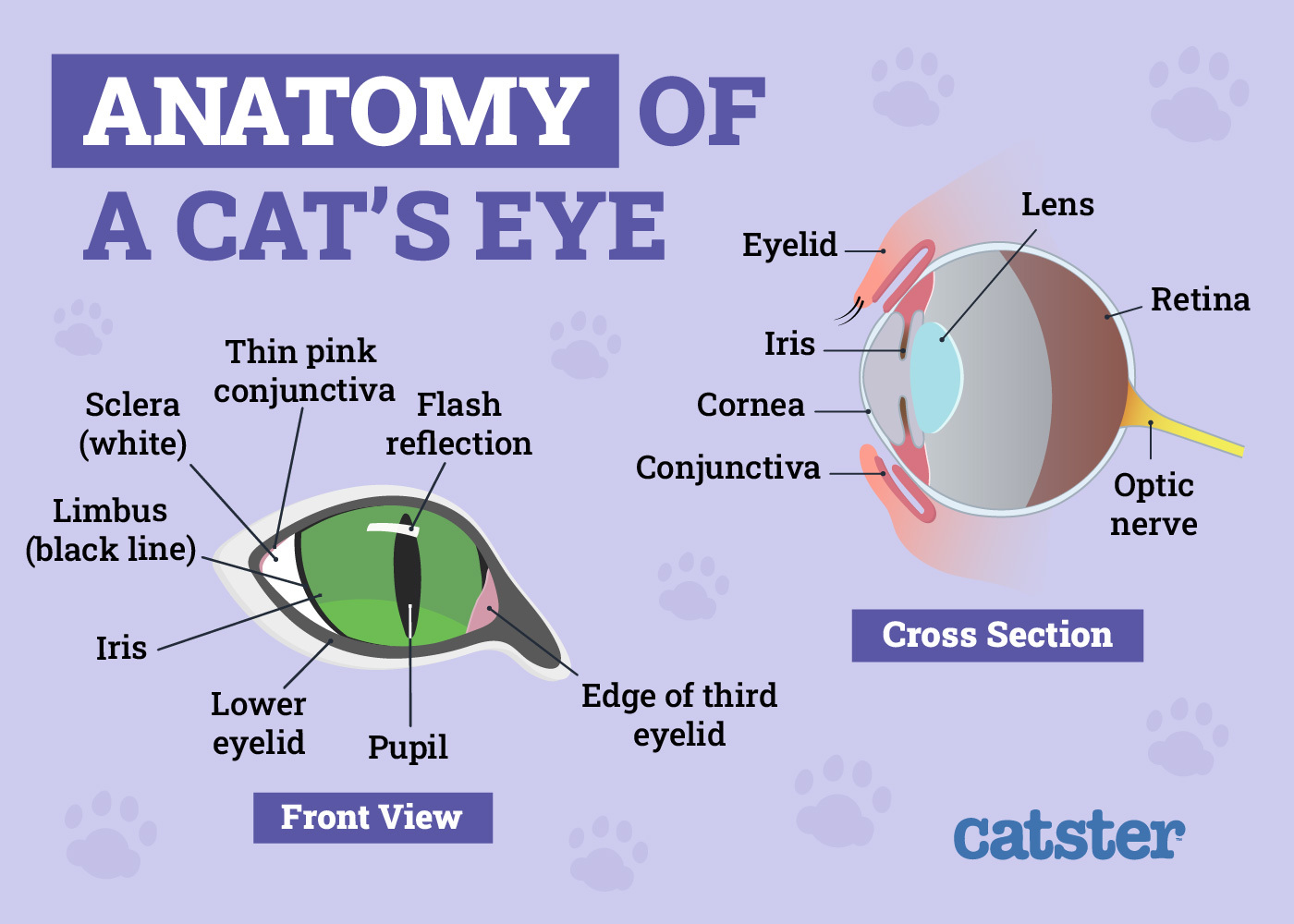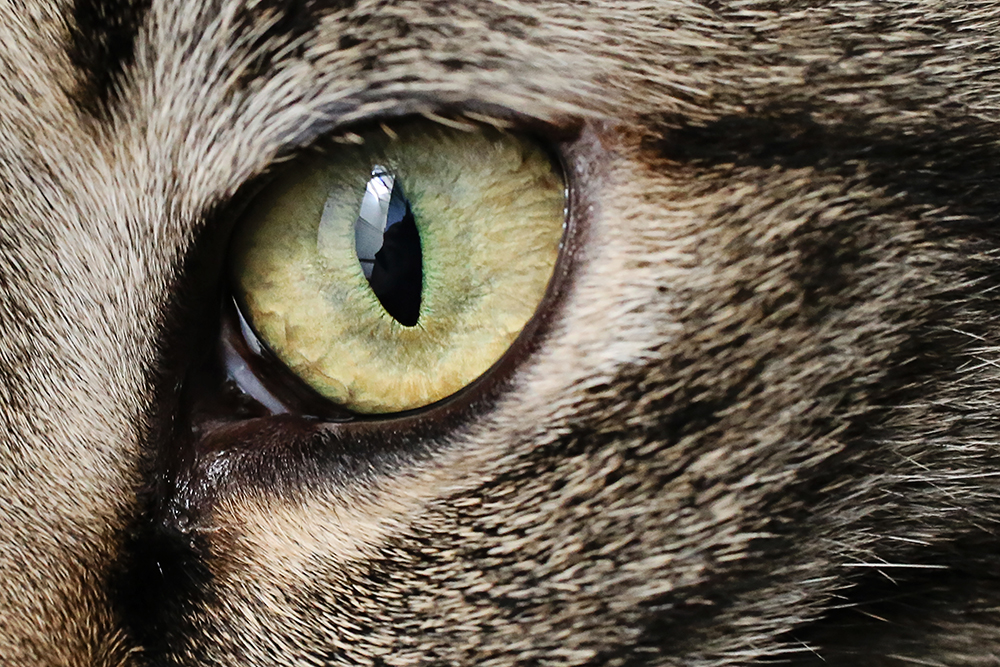The post Why Do Cats Have Slit Pupils? Feline Anatomy Explained (Vet-Verified) by Misty Layne appeared first on Catster. Copying over entire articles infringes on copyright laws. You may not be aware of it, but all of these articles were assigned, contracted and paid for, so they aren't considered public domain. However, we appreciate that you like the article and would love it if you continued sharing just the first paragraph of an article, then linking out to the rest of the piece on Catster.com.
Click to Skip Ahead
Do you ever sit and watch your kitty at play, chasing after a bug or looking intently out the window, and wonder how they see the world? Feline eyes have some similarities to human eyes but also have differences; for example, take the pupil. Cats have slit pupils, while ours are round.
But why do cats have slit pupils? What’s the purpose? The reason our favorite felines have vertical slit pupils is because they are predators; think of this pupil shape as an evolutionary advantage. Here’s a closer look at the anatomy of the feline eye and how slit pupils help kitties hunt down prey.

Structure of the Feline Eye
Before we discuss the pupil of a cat’s eye in detail, let’s briefly examine the structure of the feline eye and how it works.
Honestly, cat eyes have many similarities to our own. Like us, they have the sclera (or the outer part of the eye, known as the white of the eye). They also have an iris with a pupil in the middle. The iris is the colored part of the eye, and through the pupil, it controls how much light goes into the eye.
Feline eyes also have a lens like ours. This lens, in both felines and humans, transmits light and focuses it onto the retina to create a sharp image. However, there are some subtle differences in how the lens functions in cats versus humans. In humans, the lens changes its curvature to actively focus on objects at different distances. In contrast, a cat’s eye adjusts focus by moving the lens away or towards the retina, depending on whether it’s focusing on distant or near objects. While the accommodative power of the human eye is greater than that of a cat’s, this does not pose any disadvantage to them
Humans and felines also have retinas, though this part of the cat eye holds some differences between the two species. You’ve probably heard of two types of cells called rods and cones in your eye, also known as photoreceptors. The cat and human retina have three types of cone cells, but it’s thought that cats see far fewer colors and have a less richer color vision than we do. In fact, scientists believe they probably see colors similar to a human with red-green color blindness. Our feline friends also have far more rods in their retinas than we do, which contributes significantly to allowing them to see better in low-light conditions.
Speaking of night vision, cat eyes have a layer called the tapetum lucidum that magnifies the amount of light that reaches the retina, which gives our feline friends an amazing boost to their night vision.
Finally, the feline eye has a cornea like ours. This part of the eye is a protective layer and it is also responsible for the light refraction onto the lens, which is then focused onto the retina. The feline cornea is far larger than ours, though, which means more light can get in.
Then, of course, there’s the pupil!

Why Do Cats Have Slit Pupils?
So, why do cats have slit eyes? Because they’re hunters, and several eye features help this purpose.
The pupil of a cat’s eye is a vertical slit and thanks to this, the pupil can change its shape from being a thin line to a wide round pupil, allowing more or less light in depending on the outside light conditions. This is why sometimes a cat’s pupil is a vertical slit, and sometimes it’s big and wide. The amount of light allowed into the eye impacts the way the images are created in the brain to understand the world around a cat. Of course, different light conditions will equal different images.
Think about how large our pupils get when it’s dark; this is because our pupils are trying to get more light in so we can see better. But when we’re in brighter conditions, our pupils grow smaller to prevent dazzle in daylight. It’s the same with feline eyes. However, cat eyes are able to do that with greater finesse due to their vertical and slit-shaped pupils.
The vertical slit shape of the pupil lets a feline’s eye have greater control over the amount of light coming in. Because cats are crepuscular and do their playing and hunting during low light conditions, this gives them a great advantage while hunting. Their pupils can go extra wide to let in even the smallest amount of light so they can see their prey in the dark. During the day, their pupils go back to tiny vertical slits to keep an overabundance of light from coming in. Having a vertical slit shape also means cats can better approximate where their prey is by sharpening their depth perception.
Interestingly, large felines like tigers and lions do not have slit-shaped pupils but round-shaped. The reason for this is not exactly defined, but it is thought to be due to their greater height off the ground, their behavior as active foragers rather than ambush predators, or differences in their circadian rhythms compared to cats.


Final Thoughts
The reason cats have vertical slit pupils is because they are predators. This pupil shape provides them with the best dynamic range to allow full dilation during nighttime and great constriction to prevent dazzle in daylight, which results in cats being able to find and chase prey during high and low light conditions. The vertical slit shape of the eye gives a cat’s eye greater control over how much or how little light is allowed in when it changes shape. This shape also helps a cat better focus on their prey and reduces the amount of blur of horizontal contours. Just call it an evolutionary advantage!
- Also see: Facts About Cats’ Eyes
Featured Image Credit: photosbelkina, Shutterstock
The post Why Do Cats Have Slit Pupils? Feline Anatomy Explained (Vet-Verified) by Misty Layne appeared first on Catster. Copying over entire articles infringes on copyright laws. You may not be aware of it, but all of these articles were assigned, contracted and paid for, so they aren't considered public domain. However, we appreciate that you like the article and would love it if you continued sharing just the first paragraph of an article, then linking out to the rest of the piece on Catster.com.
from Catster https://ift.tt/yxtf02k
